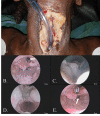Hyena Bite Injury to the Neck Leading to Laryngotracheal Separation
- PMID: 36249625
- PMCID: PMC9558360
- DOI: 10.7759/cureus.29104
Hyena Bite Injury to the Neck Leading to Laryngotracheal Separation
Abstract
Animal-induced trauma can lead to severe injury and death, especially in medically isolated settings. Few reports of hyena attacks on humans have been reported in the literature. The goal of this report is to describe such an attack and the heroic efforts required to preserve life and function in a resource-limited environment. A 55-year-old female was attacked by a hyena in a rural region of Ethiopia. Despite delays in medical care, she was able to survive this attack and was successfully discharged after prolonged treatment efforts. Animal-induced trauma is a potential source of substantial and disfiguring injury, especially in resource-limited environments. Early transfer to tertiary care centers and creative solutions are needed to optimize outcomes in such environments.
Keywords: global surgery; hyena attack; hyena bite; laryngeal trauma; laryngotracheal separation.
Copyright © 2022, Macielak et al.
Conflict of interest statement
The authors have declared that no competing interests exist.
Figures



Similar articles
-
Deadly Injuries Sustained From a Hyena Attack: The Importance of Timely Diagnosis and Treatment - A Case Report.Open Access Emerg Med. 2025 Feb 20;17:121-127. doi: 10.2147/OAEM.S509826. eCollection 2025. Open Access Emerg Med. 2025. PMID: 39995694 Free PMC article.
-
Delayed death after hyena bite in a 3-year-old Tanzanian boy: the unique reality of neurosurgery in a resource-limited setting.J Neurosurg Pediatr. 2020 Feb 28;25(6):659-662. doi: 10.3171/2019.12.PEDS19495. Print 2020 Jun 1. J Neurosurg Pediatr. 2020. PMID: 32109867
-
Hyena bite: A rare intriguing mode of maxillofacial injury, its management, risks involved, scenarios to avoid.Natl J Maxillofac Surg. 2024 Sep-Dec;15(3):530-534. doi: 10.4103/njms.njms_223_22. Epub 2024 Nov 16. Natl J Maxillofac Surg. 2024. PMID: 39830458 Free PMC article.
-
Pediatric laryngotracheal separation following a go-cart injury.Int J Pediatr Otorhinolaryngol. 2016 Jun;85:166-9. doi: 10.1016/j.ijporl.2016.03.030. Epub 2016 Apr 19. Int J Pediatr Otorhinolaryngol. 2016. PMID: 27240517 Review.
-
Combined carotid artery injury and laryngeal fracture secondary to dog bite: case report.Am Surg. 2000 Nov;66(11):1016-9. Am Surg. 2000. PMID: 11090009 Review.
References
-
- Peri-urban spotted hyena (Crocuta crocuta) in Northern Ethiopia: diet, economic impact, and abundance. Abay GY, Bauer H, Gebrihiwot K, Deckers J. Eur J Wildl Res. 2011;57:759–765.
-
- A seasonal feast: long-term analysis of feeding behaviour in the spotted hyaena (Crocuta crocuta) Cooper SM, Holekamp KE, Smale L. Afr J Ecol. 1999;37:149–160.
-
- Facial injuries following hyena attack in rural eastern Ethiopia. Fell MJ, Ayalew Y, McClenaghan FC, McGurk M. Int J Oral Maxillofac Surg. 2014;43:1459–1464. - PubMed
-
- Hyena attack of a child's head and face - plastic reconstructive surgery challenge. Lavee I, Najjar R, Ben-Meir P, Sela E, Kassif Y, Emodi O, Kogan L. https://www.ima.org.il/FilesUploadPublic/IMAJ/0/228/114225.pdf. Isr Med Assoc J. 2017;19:123–124. - PubMed
Publication types
LinkOut - more resources
Full Text Sources
